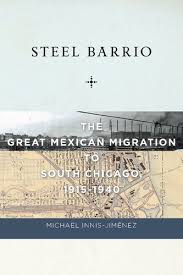Steel Barrio – Labor, Immigration, and Chicago
Getting a better understanding of Chicago – an endlessly fascinating city that never fails to engage, challenge, and surprise – is an ongoing project of mine. It’s also a project without an end. Chicago presents itself many different ways. As I have listened and learned more from many Chicagoans, I have increasingly turned to the past to try to get a better feel for the present. According to the Migration Policy Institute, Chicago is the second largest site of Mexican immigrants in the United States. (Los Angeles area is first and Houston is second). Why Chicago? How and when did this happen? Who were the first Mexican immigrants to Chicago? And what has life been for those who have journeyed from Mexico to Chicago over the years?
Great insight into these and other questions are found in Michael Innis-Jimenez’s Steel Barrio: The Great Mexican Migration to South Chicago, 1915-1940. The book is thoroughly researched and carefully argued labor and immigration history of the best kind. Innis-Jimenez is a professor of American Studies at the University of Alabama. A study of the first-wave of immigrants to Chicago, Steel Barrio goes far in explaining the foundation of the Mexican community in the windy city. It adds much to the puzzle that is Chicago.
The pull for Mexican labor came from the steel mills of South Chicago. First recruited in large numbers to break the 1919 strike, Mexican workers found themselves in a cauldron of labor and racial strife. For these early immigrant workers, their hopes and experiences were different from many other groups who moved to Chicago for economic opportunity. History, geography and citizenship laws were part of the difference. Most Mexican laborers did not express a desire to make America their long-term home. Special immigration rules and status created a mobile network for Mexican labors, who could move from job to job in the United States. Even if they remained in Chicago for years, their overall tendency – as reported by Innis-Jimenez – was to see the arrangement as temporary. They had what Innis-Jimenez calls a “sojourner” attitude, engaging in civic and cultural life differently from immigrants who believed America would be their new home.
Innis-Jimenez explains how racism and power structures limited opportunities to Mexican immigrants. Chicago was less a melting pot for immigrant groups than a city where groups competed for resources. Racism ran in many directions and life was tough. Without governmental protection and support, Mexican immigrants had to help each other. They formed mutual aid associations and other systems, formal and informal. Innis-Jimenez highlights their efforts and how the contributed to a vibrant culture and shared identity.
Sports figures prominently in the community and in Steel Barrio. Neighborhoods took great pride in their athletes and teams. Baseball was very popular. Through baseball games and Mexican inspired fairs and events, the Mexican community made claims on public space.
Innis-Jimenez provides thoughtful analysis of how gender roles and expectations shaped daily life. The immigrant community reflected very traditional Mexican gender roles. Women tended to stay home and focus on the family. Men worked and were more active in public life, but only in certain arenas. The workers tended to stay away from unions. Language was both a community bond and a barrier. Overall, Innis-Jimenez effectively helps the reader understand the community’s path to activism and achieving a greater voice in economic, political, and cultural matters.
While the history covered in Steel Barrio ends with WWII, the legacy of these early immigrants remains. It is a very good book, one that I hope is regularly taught in college classrooms. It has a pride of place in my growing library of Chicago studies.
David Potash